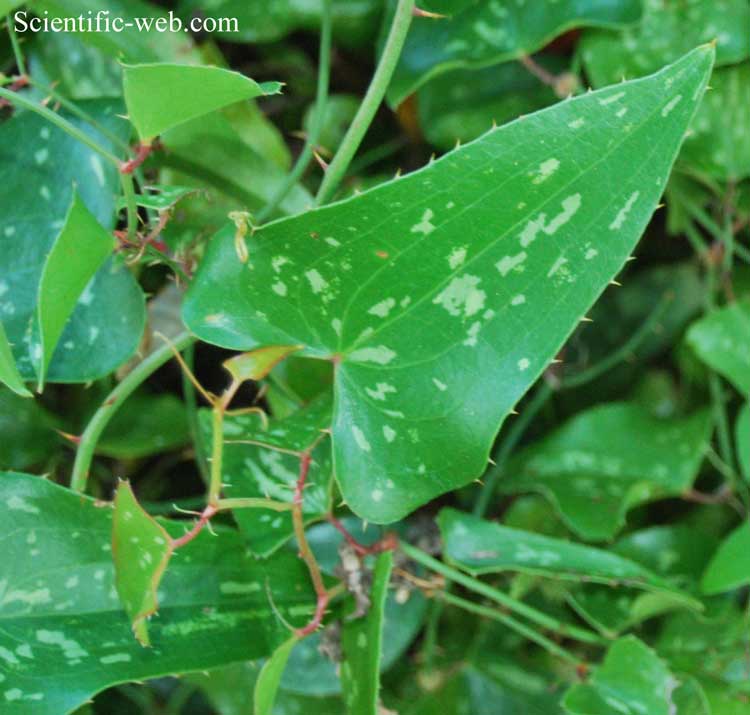
Smilax aspera, Photo: Michael Lahanas
Classification System: APG IV
Superregnum: Eukaryota
Regnum: Plantae
Cladus: Angiosperms
Cladus: Monocots
Ordo: Liliales
Familia: Smilacaceae
Genus: Smilax
Species: Smilax aspera
Name
Smilax aspera L.
References
Linnaeus, C. 1753. Species Plantarum. Tomus II: 1028. Reference page.
USDA, ARS, Germplasm Resources Information Network. Smilax aspera in the Germplasm Resources Information Network (GRIN), U.S. Department of Agriculture Agricultural Research Service. Accessed: 08-Apr-12.
Vernacular names
català: Arítjol
corsu: Raza
čeština: přestup drsný
dansk: Orientalsk Sarsaparil
Deutsch: Raue Stechwinde
Ελληνικά, Κυπριακά: Αντζουλόβατος, Αρκόβατος
English: common smilax, catbrier, greenbrier, prickly-ivy
Esperanto: Aspra smilako
suomi: Piikkisarsaparilla
français: Salsepareille
hrvatski: Tetivika
hornjoserbsce: Kałata přestupnička
Nederlands: steekwinde
српски / srpski: Тетивика/Tetivika
Smilax aspera, with common names common smilax,[2] rough bindweed,[3] sarsaparille,[4] and Mediterranean smilax, is a species of flowering vine in the greenbriar family.
Description
Smilax aspera is a perennial, evergreen climber with a flexible and delicate stem, with sharp thorns. The climbing stem is 1–4 metres (3 ft 3 in–13 ft 1 in) long.[5] The leaves are 8–10 centimetres (3.1–3.9 in) long,[5] petiolated, alternate, tough and leathery, heart-shaped, with toothed and spiny margins. It is the monocot with reticulate type of venation. Also the midrib of the underside of the leaves are provided with spines. The flowers, very fragrant, are small, yellowish or greenish, gathered in axillary racemes. The flowering period in Mediterranean regions extends from September to November. The fruits are globose berries, gathered in clusters, which ripen in Autumn. They are initially red, later turn black. They have a diameter of 8–10 millimetres (0.31–0.39 in)[5] and contain one to three tiny and round seeds. They're insipid and unpalatable to humans, but they are a source of nourishment for many species of birds.
Distribution
It is widespread in Central Africa (Democratic Republic of Congo, Kenya, Ethiopia), Mediterranean Europe (Cyprus, Albania, Croatia, Greece, Italy, Malta, Montenegro, France, Portugal, Spain), temperate Asia ( Israel, Jordan, Lebanon, Syria, Turkey) and tropical Asia (India, Bhutan, Nepal). It is also naturalized in other regions.[6]
Habitat
It grows in the woods and scrubs, at an altitude of 0–1,200 metres (0–3,937 ft) above sea level.[5]
References
"The Plant List: A Working List of All Plant Species". Retrieved 6 August 2014.
BSBI List 2007 (xls). Botanical Society of Britain and Ireland. Archived from the original (xls) on 2015-06-26. Retrieved 2014-10-17.
"Smilax aspera". Natural Resources Conservation Service PLANTS Database. USDA. Retrieved 2 February 2016.
Altervista Flora Italiana, salsapariglia, sarsaparille, rough bindweed, Smilax aspera includes photos and European distribution map
Pignatti S. - Flora d'Italia – Edagricole – 1982. Vol. III, pag. 401
"Smilax aspera". Germplasm Resources Information Network (GRIN). Agricultural Research Service (ARS), United States Department of Agriculture (USDA). Retrieved 6 August 2014.
Retrieved from "http://en.wikipedia.org/"
All text is available under the terms of the GNU Free Documentation License

